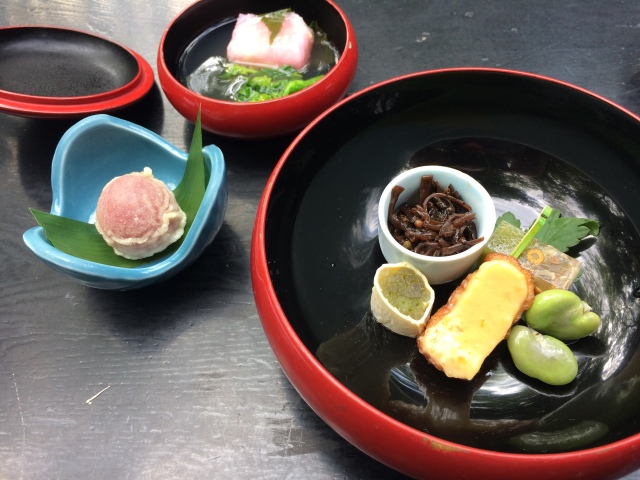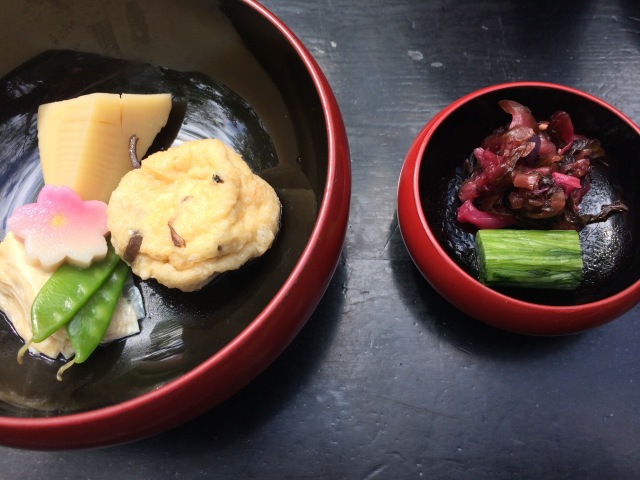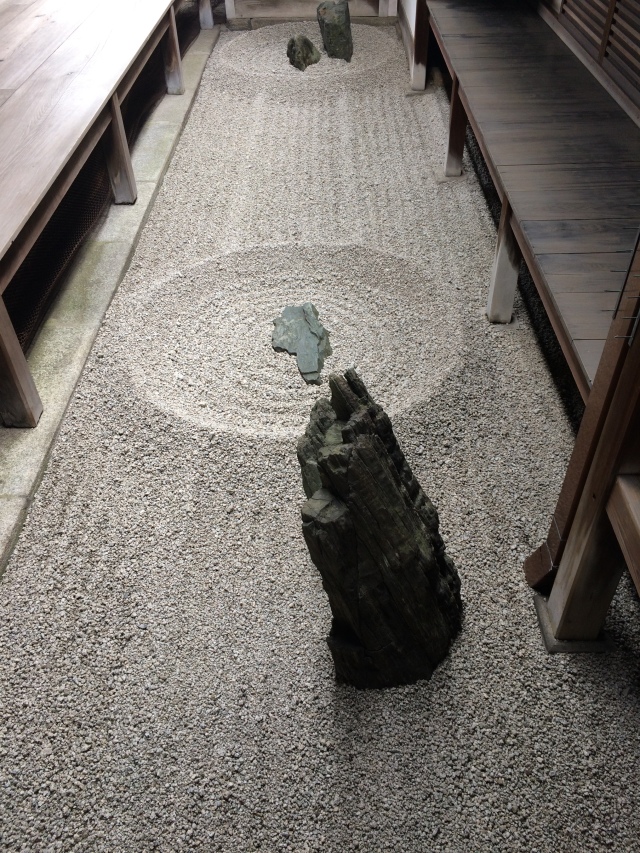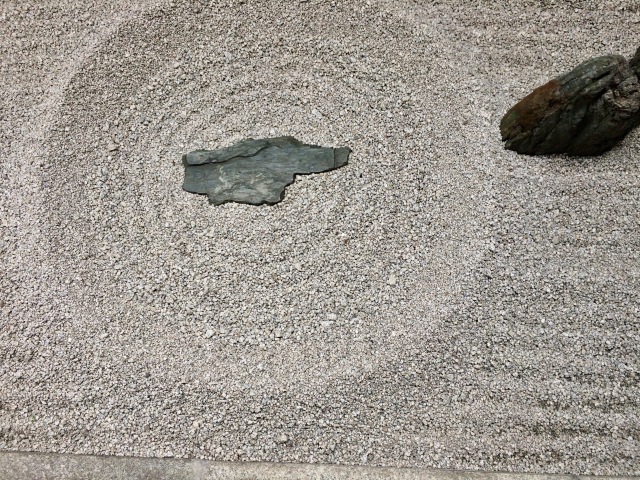 While eating shojin ryori cuisine outdoors at Izusen, Daitokuji temple, Kyoto, in spring sunshine, April past, I reflected on François Jullien’s In Praise of Blandness, the appreciation of blandness or insipidity in ancient Chinese aesthetics and ritual practices. Commenting on a text describing the use of muted music during ritual offerings to the ancestors he says this: “For the most beautiful music – the music that affects us most profoundly – does not . . . consist of the fullest possible exploitation of all the different tones. The most intensive sound is not the most intense: by overwhelming our senses, by manifesting itself exclusively and fully as a sensual phenomenon, sound delivered to its fullest extent leaves us nothing to look forward to. Our very being thus finds itself filled to the brim. In contrast, the least fully rendered sounds are the most promising, in that they have not been fully expressed, externalized, by the instrument in question, whether zither string or voice.
While eating shojin ryori cuisine outdoors at Izusen, Daitokuji temple, Kyoto, in spring sunshine, April past, I reflected on François Jullien’s In Praise of Blandness, the appreciation of blandness or insipidity in ancient Chinese aesthetics and ritual practices. Commenting on a text describing the use of muted music during ritual offerings to the ancestors he says this: “For the most beautiful music – the music that affects us most profoundly – does not . . . consist of the fullest possible exploitation of all the different tones. The most intensive sound is not the most intense: by overwhelming our senses, by manifesting itself exclusively and fully as a sensual phenomenon, sound delivered to its fullest extent leaves us nothing to look forward to. Our very being thus finds itself filled to the brim. In contrast, the least fully rendered sounds are the most promising, in that they have not been fully expressed, externalized, by the instrument in question, whether zither string or voice.

The seemingly endless succession of small dishes that form the experience of shojin ryori are not bland in the sense of being indistinguishable or boring. Each one has a particular character and subtlety of taste and texture but the cumulative effect is to balance rather than overwhelm the others. The look of them as diminutive sculpture is so striking and their taste so delicate that they leave what Jullien calls “the leftover tone, the ‘lingering’ or ‘leftover flavour’ (yiwei) [evoking] a potential, inexhaustible value . . .”

But another important aspect of shojin ryori is its relationship to time. Green tea mochi, yuba, fried plum, cherry blossom rice cake, sesame tofu, tofu skin, bamboo shoot, tempura, soup with kombu, edible flowers and ferns, bamboo and perilla leaf all follow each other at a steady pace without overlapping. They are specific to a moment yet they constitute a meal. This is consistent with many of the gardens of Kyoto temples – Zuiho-in, Kohrin-in, Oubai-in, Daisen-in, Tofukuji temple, Ryogen-in and Taizo-in. Many of them reveal themselves gradually. A corner is turned; a path is taken; a threshold is crossed. At Ryōgen-in, a small enclosed stone garden called Kodatei lies under the eaves of the study. It has another name – A-un – which represents the inhalation and exhalation of breath, indivisible pairs, positive and negative current. The dimensions of the garden are tiny, its stones visibly linked yet separated (symbolically, at least, and within deep understanding the longer it is contemplated) by a vast body of water.

In my early twenties I was drawn to a book called Animals Without Backbones, thinking that by studying invertebrates I could gain a greater understanding of the so-called formlessness of free improvisation. I was reminded of it, reading an account of “an unprecedented number of Atlantic portuguese man o’war” washing up on the Cornish coastline. Customarily thought of as jellyfish, portuguese men o’war are a species of siphonophore, a multitudinous colony of clone individuals with four specialised parts, all working together as a single organism. They go where the wind and ocean currents take them, often travelling in vast flotillas, which is why such sudden, mysterious ‘invasions’ become news.

At the Meakusma festival, Eupen, last weekend (8-10 September 2017), speaking and playing solo, I spent some hours on Sunday afternoon with Rie Nakajima and Pierre Berthet, chatting, watching them set up, then immersing myself in their installation performance. Elsewhere they have called these performances Dead Plants and Living Objects. Maybe that title was less applicable here. They set up on a hillside, objects dispersed in long grass and running down to the stream. Gusts of wind startled stretched wires and resonators into humming life. For a while I watched a large white balloon slowly deflate as it rocked gently in the breeze. Attached aerophones made no discernable sound but the scene was enlivened by flies landing on the balloon surface as if docking on a barren planet. They sought warmth but if the wind wobbled their puffy globe they would quickly vacate, then return a few seconds later.
Given their modest size, some sounding devices transmitted strongly from distance, a small part of their frequency range carrying up the hill. To walk close to them triggered curiosity, the pick-apart desire to know how they worked, but further away, where they were barely visible, a more open listening displaced this kind of focussed, analytical thinking.
The objects were scattered, half-hidden in the grass, in some cases barely visible (stretched string and wire); they could have come from a shed, a barn, the kitchen or a workshop for the manufacture of indeterminate projects. Without walls and with a cloudy sky as infinite ceiling, the dispersal and linkage of these elements felt more emphatically what I would call a distributed conglomerate instrument, close in its way to the shojin ryori aesthetic of eating, the sculpture of discrete but connected stone gardens or a drifting colony of intra-dependent entities. Muted would be a way to describe its effect; to become a part of it demanded unbeing, shedding all the blocking aspects of a fully operational human, letting go of faculties and ideas of boundedness, to enter into the world of flies as they alight on and take off from soft moving planets.


When I worked in an office I once “surprised” my co-workers by breaking out jellyfish salad for lunch. If current trends for animals without backbones are any indication, they will soon become a larger part of our diet.
Lovely writing and fantastic images as always, David.
Thank you Robin.
Pingback: Intimate Kinetics
Pingback: Rie Nakajima & Pierre Berthet / Gigaldi – Interpenetration